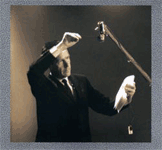|
|
 |
Dusted Reviews
Artist: John Cage Album: Cage Shock, Vols. 1-3 Label: Omega Point / Em Review date: Nov. 6, 2012 |

|
|
|
 |
Each of the three volumes of Omega Point’s hugely important Cage Shock archival releases features a marvelous black and white photograph, together perhaps underscoring the force of that second titular term. One shows the composer playing with two contact microphones, one affixed to a perched boom mike and the other to a sheaf of paper in Cage’s left hand. A second shows Cage in the middle distance, bending over a crowded table to smell from a steaming pot he has just uncovered. A third cover photo shows Yoko Ono lying atop the piano, as if she is about to be sacrificed, while three black-suited performers appear to circumambulate the instrument, apparently reading from sheets of paper. What wicked science was this? Whither music?
The discs cover Cage’s first appearances and performances in Japan during October 1962. Cage and Merce Cunningham’s visits to the country during the mid-’60s became known among Japanese listeners as “Cage shock” for the radicalism of the chance aesthetic (here realized, in the words of one reviewer, in “quiet and brutal isolation”), for the unpredictable and sometimes confrontational performance ethos, and for the at times jaw-dropping otherness of the sound itself. The performances here total approximately 120 minutes, and they represent only a fraction of what was played during this important period (one wishes, for example, for some recordings of Frederic Rzewski’s performances). Yet, what is here is a dazzling snapshot of Cage and like-minded musicians a half century ago.
Volume One opens with Toru Takemitsu’s spiky, tension-filled “Corona for Pianists,” wherein Takemitsu’s more flinty early personality is very much on display. This piece – incorporating graphic notation – is filled with lengthy silences, flurries of percussive scrabbling in the upper register, limpid pools, and very modest preparations (an overtone coaxed from a hammer daubed just so). While it sometimes has a notebook-like quality, the pianists’ use of “string piano techniques” gives it a real sonic range and frisson. It’s all played with exquisite subtlety and understanding by David Tudor (and how interesting to compare some of these recordings with Tudor’s later entries, on the essential Edition RZ) and fellow pianist Yuji Takahashi, who conjure some intense moments (for instance, the late surge of a volley of spikes followed by dark, billowing clouds from twinned pianoforte). The dynamically intense Christian Wolff piece “Duo for Pianist & Violinist” (with some sizzling, barely audible work from violinist Kenji Kobayashi) is a fairly emphatic realization of chance operations. There’s so much space, so many spectral overtones; a metallophone rattles inside the piano, followed by a declamatory single note. What’s especially pleasant is that there is, despite the uncertainty, a real flow between these events, with nothing sounding merely gestural. Ringing metallic clouds open Cage’s “Variations II” – which takes its cues from superimposed transparent sheets with graphic notation to be interpreted by performers (Cage himself alongside Tudor) – and the piece is still pretty startling at times. Its grinding, gritty metallic/electric noise must have freaked people out rather badly.
Half of the second disc features Tudor’s bracing performance of Karlheinz Stockhausen’s “Klavierstuck X.” It’s filled with crashing clusters, heavy doses of glissandi, polytonal knots, and it’s a performance that relies on energy and intensity more than on exacting technique. But the more you immerse yourself in the details of the piece – with bright, quizzical passages and plenty of fractured pauses to break up the restlessness – it’s worth noting how Stockhausen’s vaunted serialism doesn’t differ as much in method from Cage as one might think. Hear this audibly in the subsequent composition, Cage’s “26’55.998,” one of the more focused explorations of chance operations from this period. Tudor is joined by pianist Toshi Ichiyanagi and Kobayashi, and the performance is an absolute stunner. Jagged piano irruptions, woody thwacks, and grainy electronic washes of varying duration form the building blocks here, but some of the elements of “shock” are palpable, too – not just the aggressive, sheer noise but the vocalizations from an uncredited young Yoko Ono, who is deeply in tune with Cage’s conception. She rambles, mutters, and shrieks in dialogue with Tudor, and it’s all particularly effective in the comparably hushed, almost disorienting second part of the piece (with mangled, mewling noise, and whipcracks).
And on Volume Three the music continues to impress. Cage as solo performer on “0’0”” delivers a study in electronic crackle that’s positively decades ahead of its time, the kind of thing you might expect on an early Voice Crack record. Michael von Biel’s “Composition II for 2 Pianos” (Tudor and Ichiyanagi) is sensuous and subtle, with billowing clouds, micro-details, and soft timbres amidst the percussive approach. Finally, Ichiyanagi’s “Music for Piano #7” (for the same two pianists) seems superficially a bit too derivative of Cage’s “Variations,” but this is surely a case of more of a good thing; and in any case, its different graphic notation and methodology give it the sense of multiple bagatelles being strung together, for a somewhat different perceptual effect. Cage Shock, when taken together, provide a bracing distillation of these important concerts. Perhaps more vividly, they confirm how integral these musicians and their aesthetic experimentation remain to contemporary music. Essential stuff.
By Jason Bivins
|







